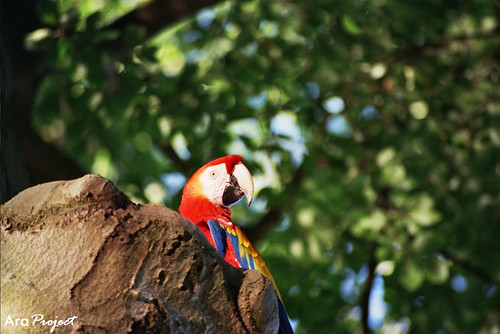 Scarlet macawWildlife: Experts estimate only 500 remain in rain forests. Poachers are the main threat, but a budding ecotourism industry may save them.
Scarlet macawWildlife: Experts estimate only 500 remain in rain forests. Poachers are the main threat, but a budding ecotourism industry may save them.
EL PERU, Guatemala — Santos Chata peers some 60 feet above to the canopy of the rain forest, where a pair of scarlet macaws preen each other and take a break from feeding two chicks in the hollow of a silver-barked cantemo tree.
Alert to company below, the pair began a raucous symphony of squawking and flapping of brilliant scarlet-colored wings, three feet from tip to tip.
Chata is a keeper at El Peru National Park in the 4-million-acre Maya Biosphere Reserve in the Peten region of northern Guatemala. He is extremely protective of this endangered species, but it is slipping away.
Macaws that survive the first year have few harmful natural predators and can live up to 45 years in the wild.
"A swarm of killer African bees attacked a macaw nest some weeks ago, the adults could only watch while their young were slowly stung to death, such a shame," Chata said sadly.
Encroaching civilization and the attractiveness of the birds to poachers, who sell them as pets, is putting pressure on the remaining few.
On the brighter side, a budding ecotourism industry may help save them.
French ecologist Santiago Billy, who has studied scarlet macaws in the reserve 300 miles north of Guatemala City for five years, figures there are only 500 macaws left wild in Guatemala's tropical forest.
"The destruction of habitat by loggers and immigrants, the hunting and poaching of chicks, which is doubly damaging because often poachers fell trees to get the baby macaws, will ultimately mean the extinction of the species unless it is stopped now," Billy said.
In Latin America, 16 species of macaws soar through the region's tropical forests, distinguished among the world's 340 parrot species by their long, colorful tails and huge, powerful beaks. Nine species, including the scarlet, are endangered or threatened.
Macaws, considered highly intelligent, appear to mate for life. They produce two eggs a year. Both parents feed the young by regurgitating swallowed nuts and fruit stored in a throat pouch.
Poachers care little that Guatemala signed an international agreement banning trade of any endangered species. For them a macaw chick might bring $300, an adult bird $4,000, on foreign markets.
Ecotourism, however, is making inroads in the region. If it holds, local communities will have an economic alternative to poaching or felling large areas of forest for agricultural use.
"Ecotourism dollars makes protecting the environment a profitable business for locals," said Carlos Sosa, director of Conservation International Guatemala, as his dugout canoe slipped easily through wetlands to the fast-flowing San Pedro river leading to El Peru.
The group's ecotourism package, managed by local forest communities, will be monitored by biologists and environmentalists who will limit the number of tourists visiting El Peru and other park areas.
Unless deforestation is drastically reduced, scientists say the Maya Biosphere Reserve, the largest in Central America, will be cleared by the year 2010.